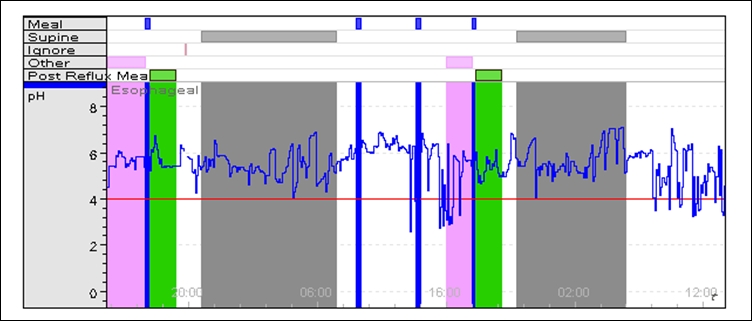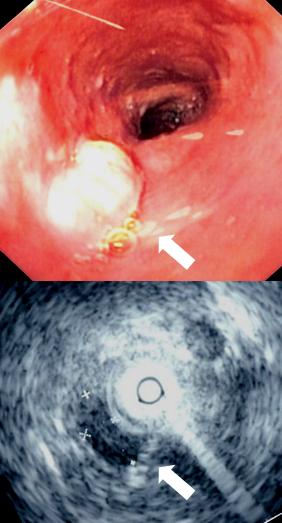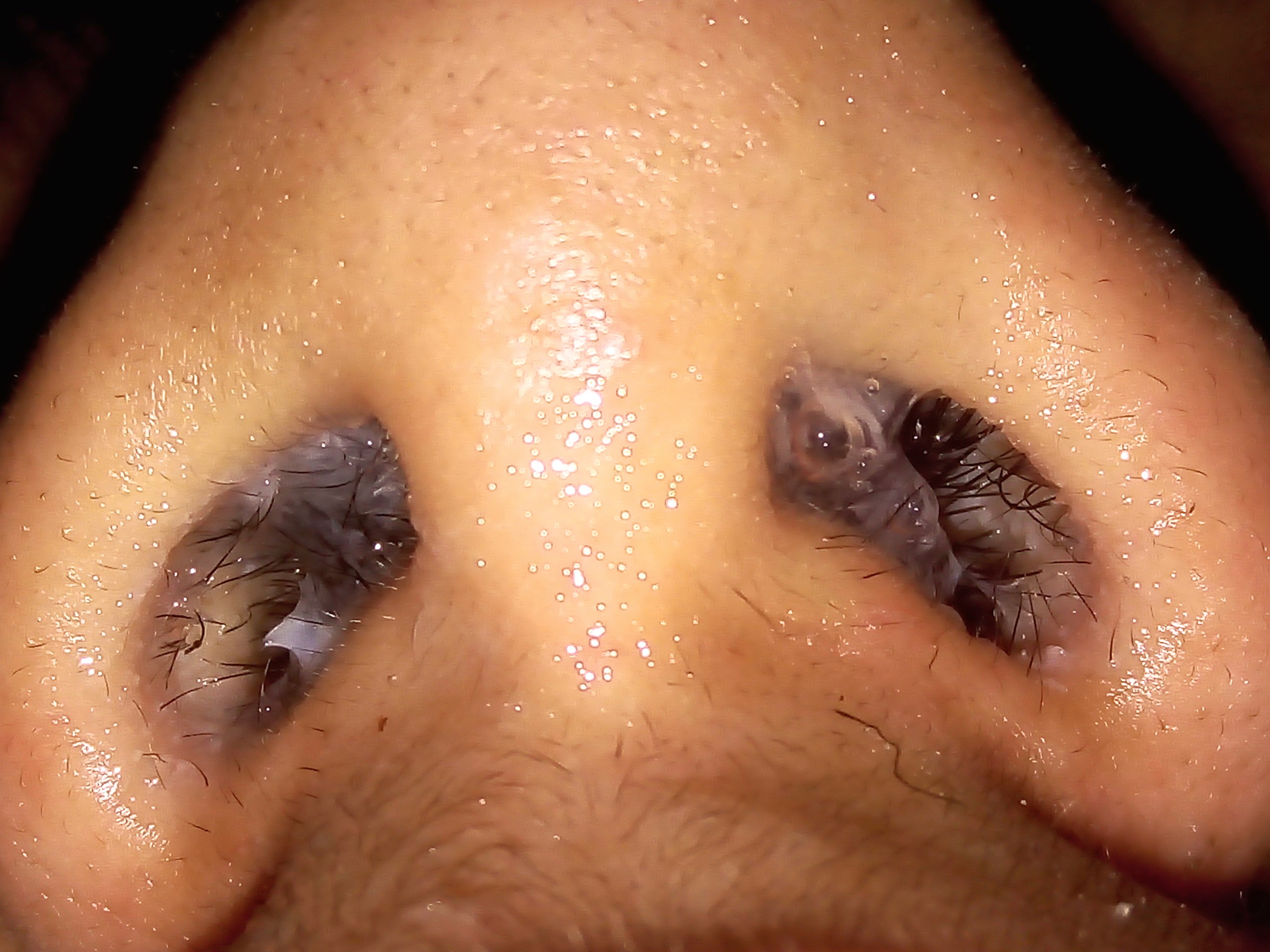|
Esophageal PH Monitoring
Esophageal pH monitoring is the current gold standard for diagnosis of gastroesophageal reflux disease (GERD). It provides direct physiologic measurement of acid in the esophagus and is the most objective method to document reflux disease, assess the severity of the disease and monitor the response of the disease to medical or surgical treatment. It can also be used in diagnosing laryngopharyngeal reflux. Background The importance of refluxed gastric contents in the pathogenesis of GERD was emphasized by Winkelstein who introduced the term " peptic esophagitis" and by Bernstein and Baker who reported the symptom of heartburn following instillation of hydrochloric acid in the distal esophagus in what was then became known as the acid perfusion test. Formal measurement of acid in the esophagus was first described in 1960 by Tuttle. He used a glass pH probe to map the gastroesophageal pH gradient, and demonstrated a sharp gradient in normal subjects and a gradual, sloping gradi ... [...More Info...] [...Related Items...] OR: [Wikipedia] [Google] [Baidu] |
Gold Standard (test)
In medicine and statistics, a gold standard test is usually the diagnostic test or benchmark that is the best available under reasonable conditions. In other words, a gold standard is the most accurate test possible without restrictions. Both meanings are different because for example, in medicine, dealing with conditions that would require an autopsy to have a perfect diagnosis, the gold standard test would be the best one that keeps the patient alive instead of the autopsy. In medicine "Gold standard" can refer to the criteria by which scientific evidence is evaluated. For example, in resuscitation research, the "gold standard" test of a medication or procedure is whether or not it leads to an increase in the number of neurologically intact survivors that walk out of the hospital.''ACLS: Principles and Practice''. p. 62. Dallas: American Heart Association, 2003. . Other types of medical research might regard a significant decrease in 30-day mortality as the gold standard. The ... [...More Info...] [...Related Items...] OR: [Wikipedia] [Google] [Baidu] |
Heartburn
Heartburn, also known as pyrosis, cardialgia or acid indigestion, is a burning sensation in the central chest or upper central abdomen. Heartburn is usually due to regurgitation of gastric acid (gastric reflux) into the esophagus. It is the major symptom of gastroesophageal reflux disease (GERD). Other common descriptors for heartburn (besides burning) are belching, nausea, squeezing, stabbing, or a sensation of pressure on the chest. The pain often rises in the chest (directly behind the breastbone) and may radiate to the neck, throat, or angle of the arm. Because the chest houses other important organs besides the esophagus (including the heart and lungs), not all symptoms related to heartburn are esophageal in nature. The cause will vary depending on one's family and medical history, genetics, if a person is pregnant or lactating, and age. As a result, the diagnosis will vary depending on the suspected organ and the inciting disease process. Work-up will vary depending on ... [...More Info...] [...Related Items...] OR: [Wikipedia] [Google] [Baidu] |
Proton Pump Inhibitors
Proton-pump inhibitors (PPIs) are a class of medications that cause a profound and prolonged reduction of stomach acid production. They do so by irreversibly inhibiting the stomach's H+/K+ ATPase proton pump. They are the most potent inhibitors of acid secretion available. Proton-pump inhibitors have largely superseded the H2-receptor antagonists, a group of medications with similar effects but a different mode of action, and antacids. PPIs are among the most widely sold medications in the world. The class of proton-pump inhibitor medications is on the World Health Organization's List of Essential Medicines. Omeprazole is the specific listed example. Medical uses These medications are used in the treatment of many conditions, such as: * Dyspepsia * Peptic ulcer disease including after endoscopic treatment for bleeding * As part of ''Helicobacter pylori'' eradication therapy * Gastroesophageal reflux disease (GERD or GORD) including symptomatic endoscopy-negative reflux d ... [...More Info...] [...Related Items...] OR: [Wikipedia] [Google] [Baidu] |
Gastroesophageal Junction
The stomach is a muscular, hollow organ in the gastrointestinal tract of humans and many other animals, including several invertebrates. The stomach has a dilated structure and functions as a vital organ in the digestive system. The stomach is involved in the gastric phase of digestion, following chewing. It performs a chemical breakdown by means of enzymes and hydrochloric acid. In humans and many other animals, the stomach is located between the oesophagus and the small intestine. The stomach secretes digestive enzymes and gastric acid to aid in food digestion. The pyloric sphincter controls the passage of partially digested food (chyme) from the stomach into the duodenum, where peristalsis takes over to move this through the rest of intestines. Structure In the human digestive system, the stomach lies between the oesophagus and the duodenum (the first part of the small intestine). It is in the left upper quadrant of the abdominal cavity. The top of the stomach lies agains ... [...More Info...] [...Related Items...] OR: [Wikipedia] [Google] [Baidu] |
Endoscopy
An endoscopy is a procedure used in medicine to look inside the body. The endoscopy procedure uses an endoscope to examine the interior of a hollow organ or cavity of the body. Unlike many other medical imaging techniques, endoscopes are inserted directly into the organ. There are many types of endoscopies. Depending on the site in the body and type of procedure, an endoscopy may be performed by either a doctor or a surgeon. A patient may be fully conscious or anaesthetised during the procedure. Most often, the term ''endoscopy'' is used to refer to an examination of the upper part of the gastrointestinal tract, known as an esophagogastroduodenoscopy. For nonmedical use, similar instruments are called borescopes. History Adolf Kussmaul was fascinated by sword swallowers who would insert a sword down their throat without gagging. This drew inspiration to insert a camera, the next problem to solve was how to insert a source of light, as they were still relying on candles ... [...More Info...] [...Related Items...] OR: [Wikipedia] [Google] [Baidu] |
Upper Esophageal Sphincter
The esophagus (American English) or oesophagus (British English; both ), non-technically known also as the food pipe or gullet, is an organ in vertebrates through which food passes, aided by peristaltic contractions, from the pharynx to the stomach. The esophagus is a fibromuscular tube, about long in adults, that travels behind the trachea and heart, passes through the diaphragm, and empties into the uppermost region of the stomach. During swallowing, the epiglottis tilts backwards to prevent food from going down the larynx and lungs. The word ''oesophagus'' is from Ancient Greek οἰσοφάγος (oisophágos), from οἴσω (oísō), future form of φέρω (phérō, “I carry”) + ἔφαγον (éphagon, “I ate”). The wall of the esophagus from the lumen outwards consists of mucosa, submucosa (connective tissue), layers of muscle fibers between layers of fibrous tissue, and an outer layer of connective tissue. The mucosa is a stratified squamous epithelium ... [...More Info...] [...Related Items...] OR: [Wikipedia] [Google] [Baidu] |
Proximal
Standard anatomical terms of location are used to unambiguously describe the anatomy of animals, including humans. The terms, typically derived from Latin or Greek roots, describe something in its standard anatomical position. This position provides a definition of what is at the front ("anterior"), behind ("posterior") and so on. As part of defining and describing terms, the body is described through the use of anatomical planes and anatomical axes. The meaning of terms that are used can change depending on whether an organism is bipedal or quadrupedal. Additionally, for some animals such as invertebrates, some terms may not have any meaning at all; for example, an animal that is radially symmetrical will have no anterior surface, but can still have a description that a part is close to the middle ("proximal") or further from the middle ("distal"). International organisations have determined vocabularies that are often used as standard vocabularies for subdisciplines of anatom ... [...More Info...] [...Related Items...] OR: [Wikipedia] [Google] [Baidu] |
Esophageal Manometry
An esophageal motility study (EMS) or esophageal manometry is a test to assess motor function of the upper esophageal sphincter (UES), esophageal body and lower esophageal sphincter (LES). Indications An EMS is typically done to evaluate suspected disorders of motility or peristalsis of the esophagus. These include achalasia, diffuse esophageal spasm, nutcracker esophagus and hypertensive lower esophageal sphincter. These disorders typically present with dysphagia, or difficulty swallowing, usually to both solids and liquids even initially. Other patients with spasm disorders may have the test done to diagnose chest pain thought not to be of cardiac cause. The test is not useful for anatomical disorders of the esophagus (that is, disorders that distort the anatomy of the esophagus), such as peptic strictures and esophageal cancer. Procedure A technician places a catheter into the nose and then guides it into the stomach. Once placed in the stomach lining, the catheter is slow ... [...More Info...] [...Related Items...] OR: [Wikipedia] [Google] [Baidu] |
Lower Esophageal Sphincter
The esophagus (American English) or oesophagus (British English; both ), non-technically known also as the food pipe or gullet, is an organ in vertebrates through which food passes, aided by peristaltic contractions, from the pharynx to the stomach. The esophagus is a fibromuscular tube, about long in adults, that travels behind the trachea and heart, passes through the diaphragm, and empties into the uppermost region of the stomach. During swallowing, the epiglottis tilts backwards to prevent food from going down the larynx and lungs. The word ''oesophagus'' is from Ancient Greek οἰσοφάγος (oisophágos), from οἴσω (oísō), future form of φέρω (phérō, “I carry”) + ἔφαγον (éphagon, “I ate”). The wall of the esophagus from the lumen outwards consists of mucosa, submucosa (connective tissue), layers of muscle fibers between layers of fibrous tissue, and an outer layer of connective tissue. The mucosa is a stratified squamous epithelium ... [...More Info...] [...Related Items...] OR: [Wikipedia] [Google] [Baidu] |
Bravo Tracing
Bravo(s) or The Bravo(s) may refer to: Arts and entertainment Music Groups and labels *Bravo (band), a Russian rock band *Bravo (Spanish group), represented Spain at Eurovision 1984 *Bravo Music, an American concert band music publishing company Albums * ''Bravo'' (5566 album) or the title song, 2008 * ''Bravo'' (Dr. Sin album), 2007 * ''Bravo!'' (EP), by Up10tion, or the title song, 2015 *''Bravo!'', by Friska Viljor, 2006 *''Bravo!'', by Tube, 1997 Literature *''The Bravo'', an 1831 novel by James Fenimore Cooper * ''Bravo'' (magazine), a European German-language teen magazine * ''Bravo'' (Romanian magazine), a teen magazine Television *Bravo (American TV network), a cable television network * Bravo (British TV channel), a digital television channel 1985–2011 *Bravo (Canada), now CTV Drama Channel, a specialty arts television channel *Bravo (New Zealand), a free-to-air channel * ''Bravo!'' (TV series), a 1975–1976 Brazilian telenovela * ''Bravo TV'' (TV series), a 1985� ... [...More Info...] [...Related Items...] OR: [Wikipedia] [Google] [Baidu] |
Telemetric
Telemetry is the in situ collection of measurements or other data at remote points and their automatic transmission to receiving equipment (telecommunication) for monitoring. The word is derived from the Greek roots ''tele'', "remote", and ''metron'', "measure". Systems that need external instructions and data to operate require the counterpart of telemetry, telecommand. Although the term commonly refers to wireless data transfer mechanisms (e.g., using radio, ultrasonic, or infrared systems), it also encompasses data transferred over other media such as a telephone or computer network, optical link or other wired communications like power line carriers. Many modern telemetry systems take advantage of the low cost and ubiquity of GSM networks by using SMS to receive and transmit telemetry data. A ''telemeter'' is a physical device used in telemetry. It consists of a sensor, a transmission path, and a display, recording, or control device. Electronic devices are widely used ... [...More Info...] [...Related Items...] OR: [Wikipedia] [Google] [Baidu] |
Rhinorrhea
Rhinorrhea, rhinorrhoea, or informally runny nose is the free discharge of a thin mucus fluid from the nose; it is a common condition. It is a common symptom of allergies ( hay fever) or certain viral infections, such as the common cold or COVID-19. It can be a side effect of crying, exposure to cold temperatures, cocaine abuse, or drug withdrawal, such as from methadone or other opioids. Treatment for rhinorrhea is not usually undertaken, but there are a number of medical treatments and preventive techniques. The term was coined in 1866 from the Greek ''rhino-'' ("of the nose") and ''-rhoia'' ("discharge" or "flow"). Signs and symptoms Rhinorrhea is characterized by an excess amount of mucus produced by the mucous membranes that line the nasal cavities. The membranes create mucus faster than it can be processed, causing a backup of mucus in the nasal cavities. As the cavity fills up, it blocks off the air passageway, causing difficulty breathing through the nose. Air ... [...More Info...] [...Related Items...] OR: [Wikipedia] [Google] [Baidu] |






